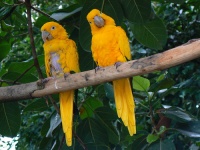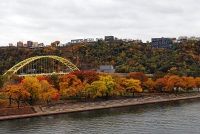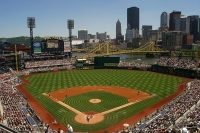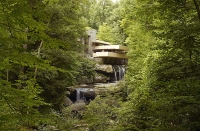City guides


Pittsburgh Travel Guide
The city of Pittsburgh was built on the legacy of tough and hardworking immigrants, drawn to the jobs offered by its steel mills. It sits back on its laurels and offers a more leisurely and aesthetically pleasing lifestyle to locals and foreigners alike.
Once dubbed the 'Smoky City', Pittsburgh's mills have closed down and the emphasis now is on making the most of the city's natural beauty. Students have replaced factory workers, the smoking chimneys now supplanted by lively restaurants, bars, and museums.
The city lies between the Ohio, Allegheny, and Monongahela Rivers, against the backdrop of the Allegheny Mountains. For this reason, it boasts the largest concentration of pleasure boats in the United States.
There is a clean, friendly metropolitan centre filled with trees, shops, restaurants, museums, galleries, and theatres. Attractions abound in this scenic city, from one of the world's fastest continuous track rollercoasters to the Andy Warhol Museum.
For fresh air, there are free summer concerts in a beautiful park. Pittsburgh has retained its gritty industrial charm but has supplemented this industrious heritage with boundless recreational opportunities and unexpected scenic nooks.
Things to do in Pittsburgh
Set between rivers and sprawling across seven hills, a holiday in Pittsburgh offers a plethora of leisure options in a city built on the hard work and struggle of immigrant labour. It has neighbourhoods rich in culture, as well as important traditional treasures.
Pittsburgh is filled with things to do and see, from an 18th-century French fortress to the National Aviary. Strolling along the many picturesque footpaths is a pleasant way to while away the hours, boasting more bridges than any other city in the USA.
Culture enthusiasts will, in particular, enjoy vacations in Pittsburgh, which sports world-class museums, theatres, and the famed Carnegie Library. The Burgh also appeals to anyone interested in industrial history and architecture.
The best seasons to travel to Pittsburgh are spring and autumn when the weather is pleasantly mild. These seasons occur during the months of April, May, September and October. Summers tend to endure uncomfortable heat waves, while winters are bitterly cold.
Carnegie Museums
In 1895, Pittsburgh industrialist Andrew Carnegie established an institute, which he intended to improve and educate local people. Today, his ideal is realised in the form of a collection of four museums funded by the Carnegie Institute: a Museum of Art, Natural History, a Science Center, and The Andy Warhol Museum. The Carnegie Museum of Art on Forbes Avenue has a notable collection of contemporary art that includes film and video works. The adjacent Natural History Museum takes visitors on a trip through time detailing the wonders of planet earth. The Carnegie Science Centre at Allegheny Avenue offers planetarium and laser shows and a variety of hands-on activities and exhibits for old and young. The final museum in the Carnegie bouquet is the Andy Warhol in Sandusky Street, featuring extensive permanent collections of art and archives relating to one of the most influential American artists of the 20th century.

National Aviary
Situated in historic West Park on Pittsburgh's North Side, the National Aviary is a few minutes from downtown. It's the only independent indoor non-profit bird zoo in the USA and home to more than 600 birds of more than 200 species, many of which are threatened and endangered. There are birds from just about every corner of the world, from hummingbirds to Andean condors. The zoo places emphasis on rainforest and wetland habitats with most birds kept in natural planted exhibits, allowing for close up views. The National Aviary is a great family attraction in Pittsburgh.

Point State Park
Formerly a slum, Point State Park in Downtown Pittsburgh is now a recreational delight. Declared a National Historic Landmark, it played a key strategic role during the French and Indian War in the middle of the 1700s. Paved promenades feature along the Ohio riverfront, providing dramatic views of the city with its busy waterways, scenic hillsides, and bridges. The park is naturally landscaped and enhanced by a 150-foot (46m) fountain. There's also a biking trail and an inline skating route. The Fort Pitt Museum is housed in one of the five original bastions of the ruined fort, devoted to displaying local history. The Fort Pitt Blockhouse is the oldest authentic building in Western Pennsylvania and is also open to the public.

PNC Park
Since its opening in 2001, PNC Park has awed all those who've entered it. Consistently voted in the top three of all baseball stadia in America, PNC Park is a breath-taking example of how sports stadium architecture can be both artful and spectator-friendly. With a capacity of just under 40,000, it is a relatively small stadium. But even the cheap seats command perfect views of the playing diamond. Beyond the bleachers, views of the river, the Roberto Clemente Bridge, Pittsburgh's skyline, and towering Mount Washington catch the eye. While daytime tours of the stadium are thoroughly rewarding, visitors to Pittsburgh should do their best to attend a Pirates game. A magical atmosphere bubbles inside PNC Park as evening descends, the city lights starting to sparkle in the distance.

Fallingwater
Just 60 miles (about 95km) southeast of Pittsburgh on Interstate 76, Fallingwater is a must-see attraction for visitors to the area. Designed by Frank Lloyd Wright in 1935 for retail giant Edgar J. Kaufman, the house sits among the waterfalls and woods of the beautiful Bear Run Nature Reserve. It remains arguably the world's best example of organic architecture. A wondrous achievement, Wright managed to design a fully functioning personal residence that blends fluidly and harmoniously with its natural setting. The sound of rushing water is a constant, a whispering presence within the house. A boulder juts out into the living room and doubles as a hearth, while the windows open outward from the corners of the walls and leave no panes to obstruct the natural view. This triumphant feat of individualistic artistic expression so inspired Ayn Rand that she largely based her novel The Fountainhead on the ingenuous creation. Fallingwater is included in the Smithsonian magazine's list of '28 places to see before you die' and visitors to Pennsylvania shouldn't pass up the opportunity.
Getting Around
Downtown Pittsburgh is compact and designed to benefit pedestrians, with parks and plazas spaced out between the office towers and shopping streets. If visitors need to travel further, they descend to the subway known locally as the 'T'. It's a small, clean, and reliable light rail system.
The city has an extensive bus network with multiple routes connecting downtown to the attractions on the north side, as well as Oakland and surrounding neighbourhoods. The Central Business District is a Free Fare Zone and buses are free from 4am to 7pm daily, while the 'T' is free 24 hours a day.
Pittsburgh's taxi cabs usually need to be called by telephone or hired at a taxi rank, rather than hailed on the street. Cars rental companies offer services in the city. Uber, Lyft, and other similar ride-hailing apps and taxi services are also available.
Pittsburgh Climate and Weather
Pittsburgh's climate fluctuates between humid continental and humid subtropical, with four distinct seasons. Pittsburgh winters, between December and February, are cold, with average temperatures between 21F (-6C) and 39F (4C), although the temperature can drop significantly lower.
In spring, things warm up quickly and summers, between June and August, are hot and sunny, with a range in humidity, and temperatures averaging between 58F (14C) and 82F (28C). Pittsburgh receives heavy rainfall, which is fairly evenly distributed throughout the year, but late spring and summer tend to be the wettest. Some snow does fall in winter.
United States of America travel info
Electricity
The electrical current is 120 volts, 60Hz. Plugs are mainly the type with two flat pins, though three-pin plugs (two flat parallel pins and a rounded pin) are also widely used. European appliances without dual-voltage capabilities will require an adapter.
Language
English is the most common language spoken but Spanish is often heard in the south-western states.
Money
The official currency is the US Dollar (USD), which is divided into 100 cents. Only major banks exchange foreign currency. ATMs are widespread and credit cards are widely accepted; Apple Pay and Google Pay are very popular. Banking hours are Monday to Friday 9am to 3pm.
Tipping
A 15 percent tip is expected by taxi drivers, bartenders, hairdressers and waiters, but travellers shouldn't tip in fast-food or self-service restaurants. In expensive restaurants or for large parties, the tip should be 20 percent of the bill. It's normal to tip staff such as valets and porters in hotels; this is discretionary, although a minimum of $5 is expected. Most services are customarily tipped if the service is good.
Health
There are no specific health risks associated with travel within the USA. Medical facilities are excellent, but expensive. Only emergencies are treated without prior payment and treatment can be refused without evidence of insurance or proof of funds. Good medical insurance is essential.
Safety
Travel within the United States is generally trouble-free, though travellers should be aware that the US shares with the rest of the world an increased threat from terrorist incidents. Security has been heightened, particularly at airports. Restrictions on hand luggage apply and travellers are advised to check on the latest situation with airlines in advance. Travellers should also be alert to the dangers of car and street crime in cities and should use common sense and take basic precautions. Hurricanes are common between June and November, putting the southern USA, including the Gulf Coast and the eastern US at risk. There's a risk of wildfires in many dry areas in the US, particularly on the West Coast from March to November.
Local customs
Laws vary from state to state, including speed limit, fines and punishment. The age at which alcohol may be legally bought and consumed is 21 years.
Doing business
In such a large country, filled with so many diverse groups, business practices may differ according to each state, though rarely to any large degree. The East Coast is traditionally more formal than the West Coast, though in states such as California, dress code and conservative appearance are as common as they would be in New York. Punctuality is important throughout the country and it's considered rude to be late for a meeting. Gift-giving is uncommon as it may be construed as bribery. Appropriate titles (Mr, Mrs, Ms) are used upon introduction and until otherwise stated. Americans favour politeness and greetings of 'Hello' and 'How are you?' are often expressed with sincerity. Business hours may vary in each state, but an 8am start and 5pm finish Monday to Friday is the most common with an hour over lunch.
Status and age are not necessarily indicative of seniority, nor do they carry much weight in themselves. Those doing business in the States should be mindful of this fact; foreigners should never make assumptions about someone's position or rank. Best practice is to be respectful to all parties. That said, the US upholds a hierarchal business structure in which 'the boss' is the ultimate decision-maker. Senior leaders have the power of the last word, and can go against the grain just as easily as they can follow popular opinion. Foreigners should concentrate on winning over this individual, even if the greater group seems unsupportive. Americans value a direct style of communication. In this fast-paced, consumer culture 'time is money', and small-talk is viewed as unnecessary and wasteful. It's best for foreigners to get to the point quickly, speak about issues in a frank and open manner, and to avoid taking offence if someone questions or challenges them outright.
Duty free
Travellers to the United States who are returning residents of the country do not have to pay duty on articles purchased abroad to the value of $800 provided their stay was longer than 48 hours and their duty-free allowance was not used in the 30-day period prior. For passengers arriving from Samoa, Guam and the U.S. Virgin Islands, a duty-free allowance of $1,600 is allowed. The following items are included in this: 50 cigarettes and 10 cigars and 150 millilitres (5 fl. oz.) of alcoholic beverages or 150 millilitres (5 fl. oz.) of perfume containing alcohol. Restrictions may apply to goods from Cuba, Iran, North Korea, Burma (Myanmar), Angola, Liberia and Sudan. It is prohibited to import Cuban cigars from any country.
Travellers to the United States who are non-residents do not have to pay duty on the following items: 50 cigars or 200 cigarettes and gifts to the value of $100 provided their stay in the USA is not less than 72 hours and that the allowance has not been used in the preceding six-month period.
Prohibited items for residents and non-residents include meat or meat products, poultry, narcotics, absinthe, plants, seeds, vegetables, fruits, soil, live insects and other living plants or animal pests. Fish is prohibited unless it carries disease-free certification. Wildlife and animals or their by-products carry restrictions. Dairy products and eggs from specified countries are not allowed. Firearms and ammunition are not allowed without the necessary license and permit.
Communications
The international country dialling code for the United States is +1. Mobile networks cover most of the country, especially all urban areas; travellers can purchase local prepaid SIM cards for unlocked phones or use eSIMs if their cellular providers support it on their networks. WiFi is widely available.
Passport & Visa
It is highly recommended that travellers' passports have at least six months' validity remaining after the intended date of departure from them travel destination. A visa is required for short visits unless travellers qualify for entry under the Visa Waiver Program.
The Visa Waiver Program (VWP) enables citizens of certain countries to travel to the US for a stay of up to 90 days without a visa. Visitors under the VWP need a valid Electronic System for Travel Authorization (ESTA), which allows the US government to screen all visitors before travel. Visitors entering the country under the VWP must have a machine-readable passport (MRP) that has a barcode on the photo page. Travellers under the VWP must have passports that include biometrics if they wish to enter the country without a visa, which means that passports must contain unique personal data such as fingerprints or iris details. All passports must contain a digital photo image in order to travel visa-free. All visitors to the USA have a photograph and two fingerprints taken by an inkless scanner on arrival, including those travelling visa-free under the VWP.
As part of the Western Hemisphere Travel Initiative (WHTI), all travellers travelling between the United States and Canada, Mexico, Bermuda, and the Caribbean region are required to present a passport or other valid travel document to enter or re-enter the United States. If departing from the USA, a valid passport is required by immigration authorities. Immigration officials often apply different rules to those stated by travel agents and official sources.
Entry requirements
US citizens require passports.
UK nationals require a passport valid for duration of stay. Most passport holders can get an Electronic System for Travel Authorisation (ESTA) through the Visa Waiver Programme, which allows travel to the US for up to 90 days. The VWP includes tourism, certain types of business visit and transit to another country.
The most important requirement on entering the U.S. is providing proof of Canadian citizenship. A valid Canadian passport is the best document to prove Canadian citizenship and the right to return to Canada. However, several other documents can serve, depending on the mode of transport. Generally, Canadian citizens do not require visitor, business, transit or other visas to enter the United States from Canada, though there are some exceptions.
Passports must be valid for the period of intended stay. If visiting the US for fewer than 90 days, Australian nationals may be eligible to apply for an Electronic System for Travel Authorization (ESTA), and enter under the Visa Waiver Program (VWP).
South Africans must hold a passport valid for duration of stay. A visa is required.
Passports must be valid for duration of stay. Irish nationals can get an Electronic System for Travel Authorisation (ESTA) under the Visa Waiver Programme for entry into the United States.
Passports must be valid for duration of stay. New Zealand nationals can get an Electronic System for Travel Authorisation (ESTA) under the Visa Waiver Programme for entry into the United States.
Useful contacts
United States Tourist Office: www.usatourist.com
911 (General)Embassies / consulates in other countries
United States Embassy, London, United Kingdom: +44 20 7499 9000.
United States Embassy, Ottawa, Canada: +1 613 688 5335.
United States Embassy, Canberra, Australia: +61 2 6214 5600.
United States Embassy, Pretoria, South Africa: +27 12 431 4000.
United States Embassy, Dublin, Ireland: +353 1 668 8777.
United States Embassy, Wellington, New Zealand: +64 4 462 6000.
Embassies / consulates in United States of America
British Embassy, Washington DC: +1 202 588 6500.
Canadian Embassy, Washington DC: +1 202 682 1740.
Australian Embassy, Washington DC: +1 202 797 3000.
South African Embassy, Washington DC: +1 202 232 4400.
Irish Embassy, Washington DC: +1 202 462 3939.
New Zealand Embassy, Washington DC: +1 202 328 4800.


